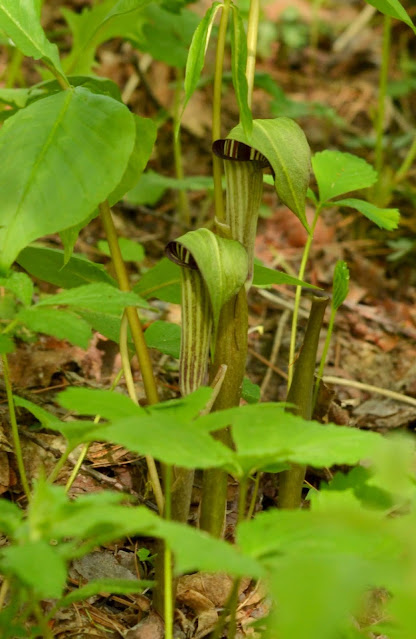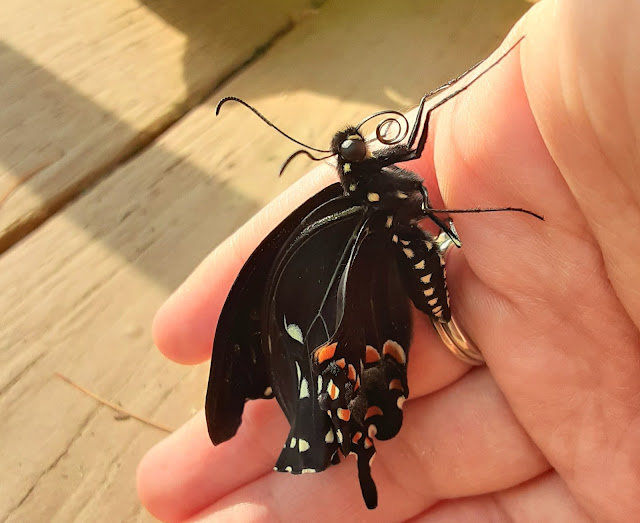I'm still catching up with 2021! Here are some assorted sights from our yard, meadow, and woods in August through October of this year.
Young Rose-breasted Grosbeaks were a steady presence in our yard in August, and they seemed to especially enjoy tasting a variety of plants in my vegetable garden. I would've preferred it if they didn't munch on the tomato and pepper blossoms -- those plants had a hard enough time already during this very wet summer -- but there were plenty of peas to go around, and I enjoyed seeing these rowdy young birds snacking away at the top of the pea trellis on August 2:
I think this young Rose-breasted Grosbeak may have struck a window on August 6 (a rare occurrence at our house, fortunately), because it sat for a few minutes on our upstairs balcony, allowing for some unusually close views before it flew off:
For the second year in a row, American Robins nested on the front of our house, making close neighbors with the Eastern Phoebes above our front door. On August 3, the stripey robin babies were looking alert and nearly ready to leave the nest:
This is actually the first year I've seen American Robins successfully produce new birds on our property -- the nests I've seen in the previous three years have all failed. And even better, there were a total of three successful American Robin broods on our property this year. Hooray for a productive year for robins!
The House Wrens were also productive this year, with two broods in their chosen nest box. Here's one of those young House Wrens on August 6:
On the morning of August 8, I was shocked to see a really big bird walking around next to our house. What in the world is a Great Blue Heron doing in our yard??
There are ponds and streams a short flight away from here, but we have no aquatic environments in our yard at all.... As it turned out, though, this Great Blue Heron was hunting food of the small furry variety, and our yard has plenty of those. We watched through a window as the heron snatched up a Meadow Vole:
Here's a closer view of the vole's plight (as clear as I could get through the window):
Down it goes:
The heron hunted over quite a bit of the yard. Look, there's a huge bird walking behind the cars (!):
The heron grabbed one more wriggling vole from the bank between the road and the driveway:
And then a passing runner startled the heron and it flew away. What a cool and unexpected visitor! Now I can add Great Blue Heron to the list of predators who sometimes stop by to keep our vole population in check.
We had so much rain this summer that our little pond in the woods kept water in it all year, instead of turning into a big muddy patch as it has done in previous years. On August 6, I was happy to see some Green Frogs hanging out in the water:
On August 8, I saw the cutest little Gray Treefrog (a young individual) in a patch of Orange Jewelweed in our yard:
I hear Gray Treefrogs frequently enough around here that they must be fairly common, but I so rarely get to see them. And this little creature was so adorable! It was climbing among the jewelweed stems, hunting tiny flying insects, and pausing long enough for a picture now and then:
This lovely Black Swallowtail showed up at the zinnias on our back deck on August 28:
While gardening in the front yard on September 3, I came across a couple of fun little creatures (and had only my phone's poor-quality camera to document them). This small Spotted Salamander was burrowed below ground, before I accidentally unearthed it:
And I found a really bizarre larva on Black Walnut leaves -- at first, I assumed this was a caterpillar infected with some sort of fungus, but it turned out to be the normal larva (they're supposed to look like this!) of a species of sawfly, the Butternut Woollyworm (Eriocampa juglandis):
On September 11, I watched a flock of Cedar Waxwings feasting on Pokeweed berries:
These birds looked so fancy surrounded by Pokeweed and blooming goldenrod:
Nearby, an industrious Eastern Chipmunk watched me from one of the many holes in the old apple tree next to our driveway:
Look at those stuffed-full cheeks!
Also on September 11, this European Mantis (Mantis religiosa) was doing its best impression of a grass stem as it staked out a patch of Little Bluestem in the meadow:
This Giant Puffball made an impressive sight in our yard on September 18:
Here's a beautiful Monarch on New England Aster on September 25:
And reddening Virginia Creeper leaves glowing in the sunlit woods:
Furrow Orbweaver spiders (Larinioides cornutus or patagiatus) commonly build webs across the outside of our windows throughout the spring, summer, and fall. This little individual found shelter in a leaf caught against a window in October, and it seems to now be spending the winter curled up in its home; this picture is from October 10:
I didn't get outside much in October and November -- fall is always a busy time. I have a few more sights to share from December 2021, and that will be the next post.




















































